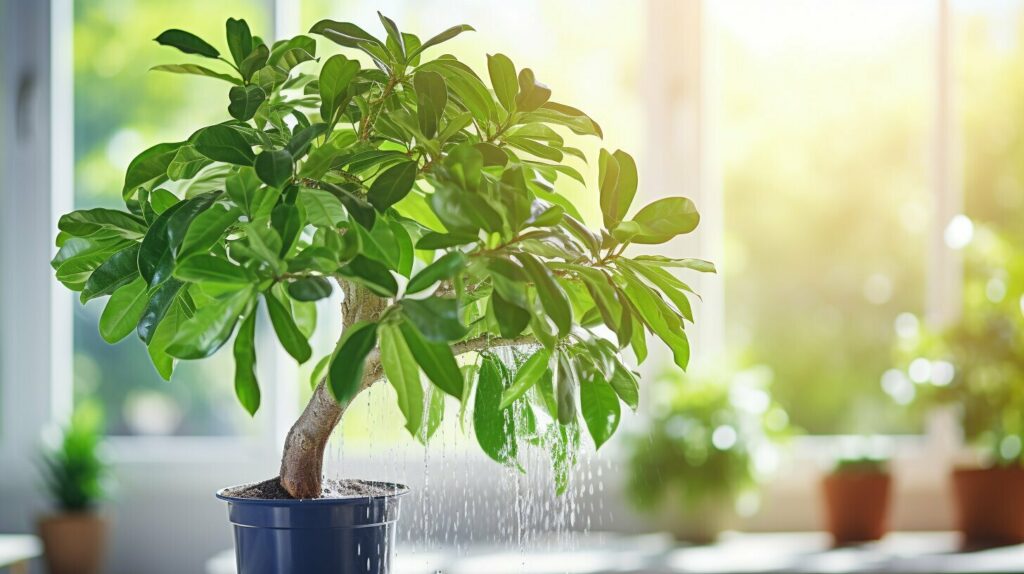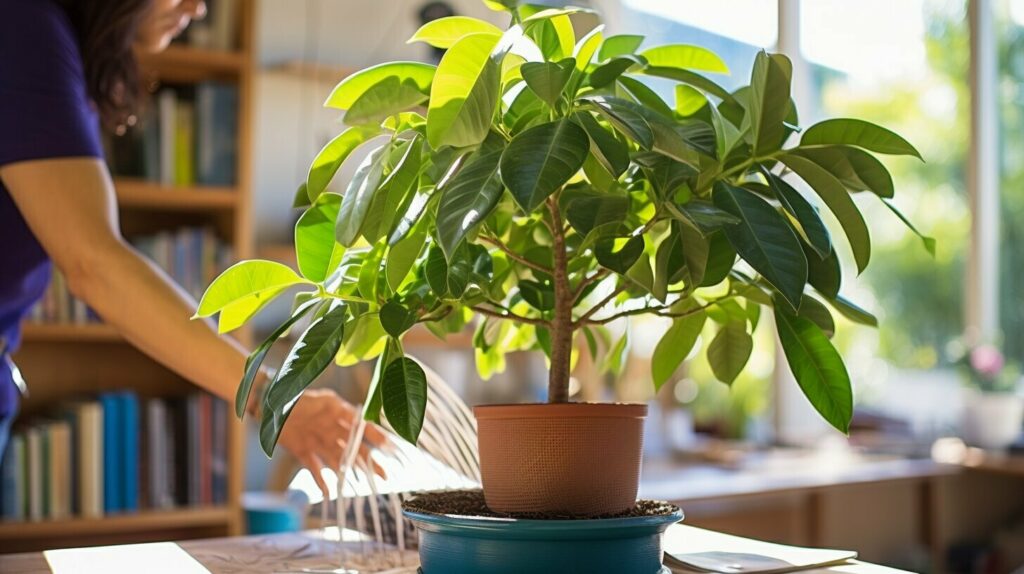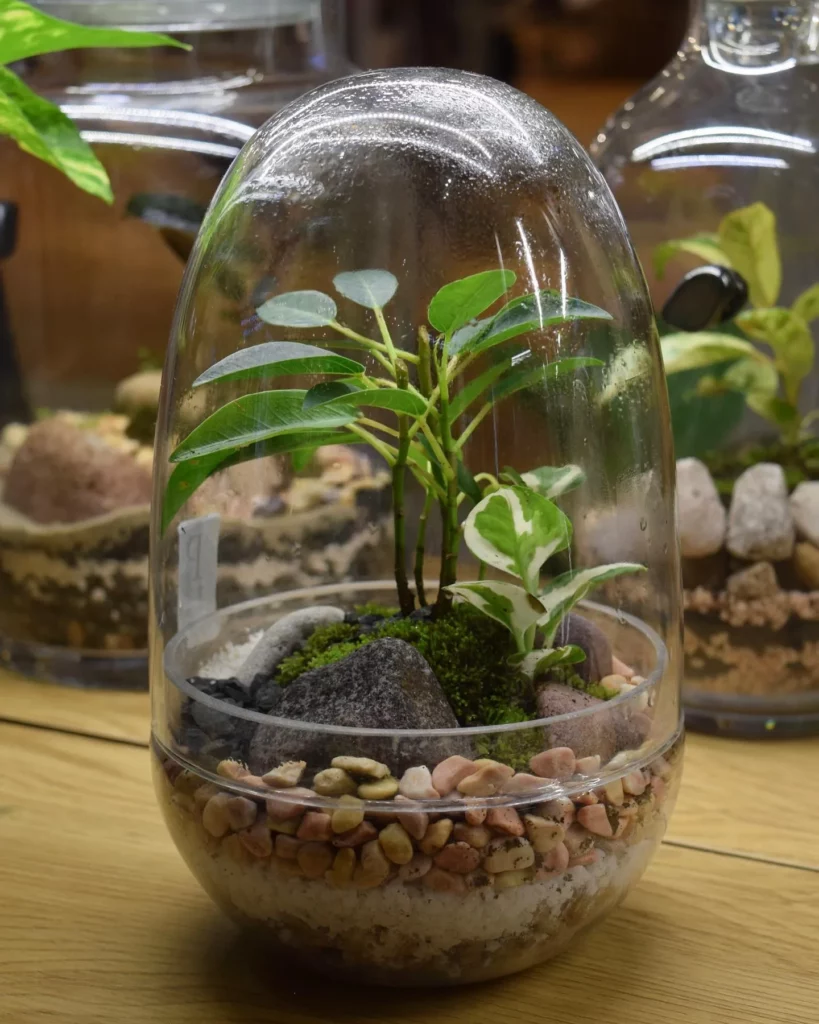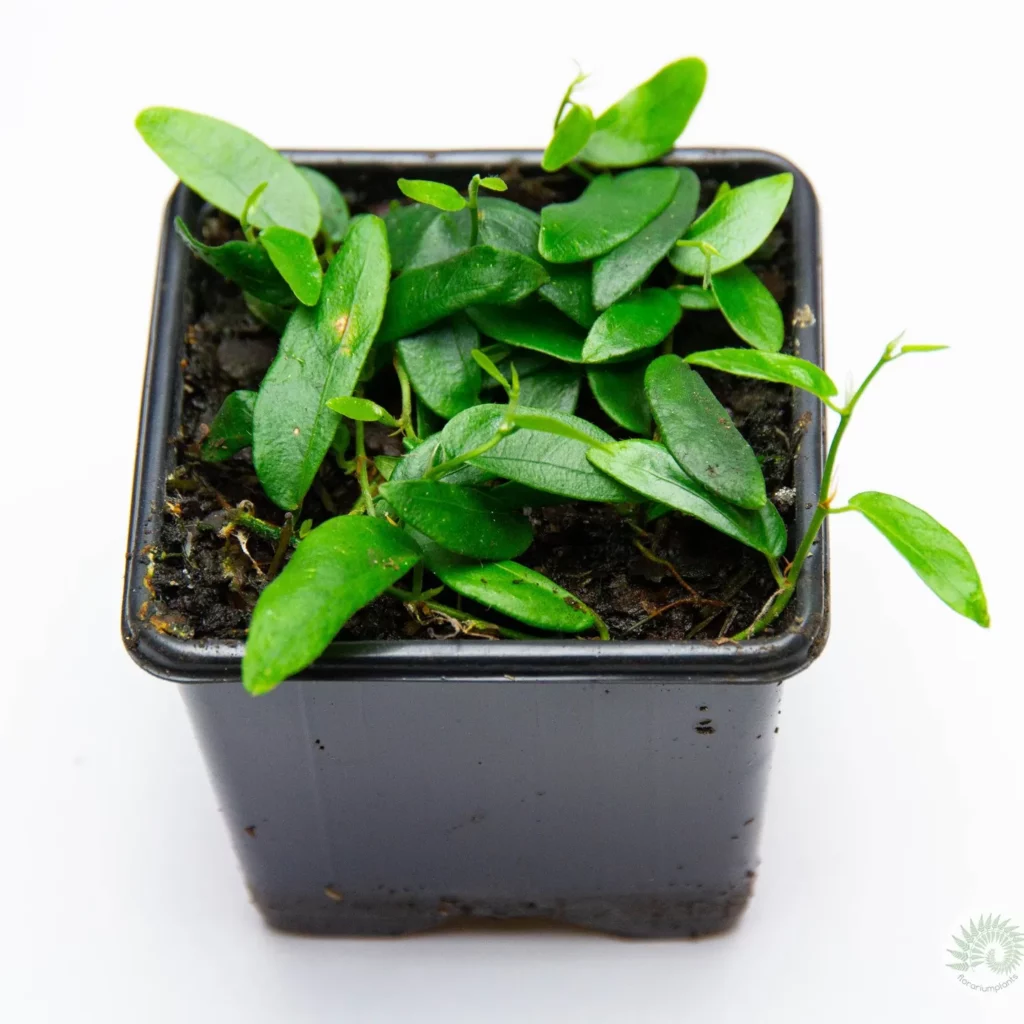Caring for a Ficus Neriifolia, also known as the willow-leaf fig or Benjamin fig, can bring joy to homeowners. Originally from India and Australia, it’s often found as an indoor tree or houseplant. Its leaves look like those of a willow and it can do well inside, making it a favorite for indoor greenery. But, taking good care of it and pruning it right are key. This keeps it healthy, long-lasting, and avoids problems.
Key Takeaways
- The Ficus Neriifolia, or willow-leaf fig, is a tropical plant suited for indoor growth as a houseplant or small tree.
- Proper lighting, watering, soil conditions, and pruning are essential for maintaining a healthy Ficus Neriifolia.
- Regular ficus neriifolia pruning helps control the plant’s size and shape, encouraging a bushier or tree-like form.
- Common ficus neriifolia problems include leaf drop, pests, and diseases like root rot, which can be addressed through proper care.
- Propagating the Ficus Neriifolia from stem cuttings allows you to create new plants from an existing specimen.
Introduction to Ficus Neriifolia
The Ficus neriifolia is known as the willow leaf fig tree. It’s from India and is part of a group with over 800 fig tree species. Its beautiful leaves are like those of a willow tree and can get up to 6 inches long.
Origins and Characteristics of the Plant
This plant comes from the warm parts of India. It has slender leaves, much like a willow tree, and thrives indoors. People love it because it can be a bushy plant or a small indoor tree. This means it can fit many different home styles.
Benefits of Growing Ficus Neriifolia Indoors
Having a Ficus neriifolia at home helps clean the air. It’s great for removing indoor pollutants. Plus, it looks beautiful. You can shape it into a tree or keep it bushy. It’s an easy plant to care for, perfect for beginners.
The Ficus neriifolia is great for freshening your air and making your home more natural. It’s a simple option for any home.
| Propagation Method | Season | Requirements |
|---|---|---|
| Stem Cuttings | Spring |
|
| Water Propagation | Spring/Summer |
|
| Winter Propagation | Winter |
|
Choose the right season for the best way to grow the Ficus neriifolia. Spring is perfect for planting from stem cuttings. If you’re using water to grow new plants, try it in spring or summer. Winter needs careful attention to keep the new plants healthy.
Lighting Requirements for Optimal Growth
It’s crucial to give your ficus neriifolia bright indirect light for the best growth. This plant needs sunlight that is bright but not direct. Too much sun can harm its leaves. Placing it by east or west-facing windows helps meet these needs well.
For some homes, natural light might not be enough. You can use special grow lights or place lamps strategically to boost light. Remember, too little light can slow down its growth and make the leaves thin.

- Ficus bonsai trees, which include the ficus neriifolia, do well in light ranging from 800 to 2000 lux.
- To do photosynthesis well, they need at least 500 lux of light.
- An average windowless office has only around 400 lux of light, which isn’t enough for these plants.
So, to keep your ficus neriifolia happy, make sure it gets enough light. Place it where it can get lots of indirect light, or add artificial light if needed.
| Light Intensity (lux) | Suitability for Ficus Neriifolia Growth |
|---|---|
| Below 500 lux | Insufficient for photosynthesis and growth |
| 500 – 800 lux | Adequate for survival but may result in sparse foliage |
| 800 – 2000 lux | Ideal range for optimal growth and development |
| Above 2000 lux | Potentially harmful, may scorch leaves |
Meeting the ficus neriifolia sunlight needs and ficus neriifolia light requirements ensures your plant thrives. It will grow lush, with leaves similar to a willow tree, as long as it gets the right light.
Watering Guidelines for Ficus Neriifolia
Keeping a good watering schedule is key for your Ficus neriifolia’s health. Too little or too much water can cause problems like yellow leaves, leaf fall, and root rot. If you learn to spot signs of bad watering, you can help your plant do well.
Signs of Over and Underwatering
Knowing the signs of ficus neriifolia overwatering and underwatering symptoms is important. Overwatering shows as yellow leaves and a bad smell, which means your plant might be rotting. Underwatering makes the plant droop and its leaves dry out. It drops leaves early too. If you see these signs, change your watering habits.
Proper Watering Techniques
To make sure your Ficus is at the right moisture level, water it until the excess flows from the pot. Don’t let your plant stand in the extra water, because this can cause root rot. In spring and summer, water when the top soil is dry, but in winter, water less often to avoid too much water.
Here are some more tips for watering your ficus neriifolia:
- Water your plant from the top down, which is a good way to keep Ficus plants healthy.
- Or water from the bottom up, so the plant pulls in the water it needs.
- Make sure your plant’s pot has holes in the bottom so water can drain out.
- How much light your Ficus gets affects how often you should water it.
- Also, the hotter and drier the air, the more you’ll need to water your plant.
- In general, big pots need water less often than small pots.
Following these how to water ficus neriifolia tips will help you keep your plant’s moisture just right. This will keep your plant growing well and looking good.
| Factor | Impact on Watering Frequency |
|---|---|
| Light Exposure | Increased light means you need to water more often. |
| Temperature | Warmer weather makes plants need more water. |
| Pot Size | Bigger pots don’t need water as much as smaller ones do. |
| Season | Plants need more water in spring and summer than in winter. |
| Indoor Humidity | Drier air means you need to water your plant more. |
Soil and Potting Mix Considerations
The right soil and potting mix are key for your Ficus Neriifolia’s health and growth. It loves a mix that drains well and is rich in nutrients but airy enough. This mix should use peat moss, perlite, and potting soil in equal parts. Heavy, dense soils are bad because they can keep too much water, causing root rot.
Ideal Soil Composition
For a ficus neriifolia potting mix, go for light and airy. It should let water flow out easily but keep enough to feed the plant. A good mix is 50% 1/16″ pumice and 50% Premier indoor potting soil. This soil has about 35% peat moss, some forest byproducts, compost humus, and a bit of perlite.
To avoid soil compaction, some mix in coco fiber. Coir-based composts and coco peat work well for potting ficus neriifolia and sturdy Euphorbias. Coir comes from the coconut industry’s leftovers, making it a possibly eco-friendlier choice than peat. But, think about how it’s shipped to you.
Repotting and Root Pruning
It’s best to repot your ficus neriifolia every 2-3 years. This keeps the soil fresh and lets the roots grow freely. When you repot, take the plant out gently, and trim any roots that are circling or damaged.
Then, put it in a bigger pot with fresh potting mix for ficus neriifolia. Make sure this new mix drains well. Root pruning can also make the plant stay a good size and get bushier.
Be careful when repotting ficus neriifolia because they don’t like being moved. Watch the plant closely after, and change how you water and care for it if needed. This helps it adjust to its new home.
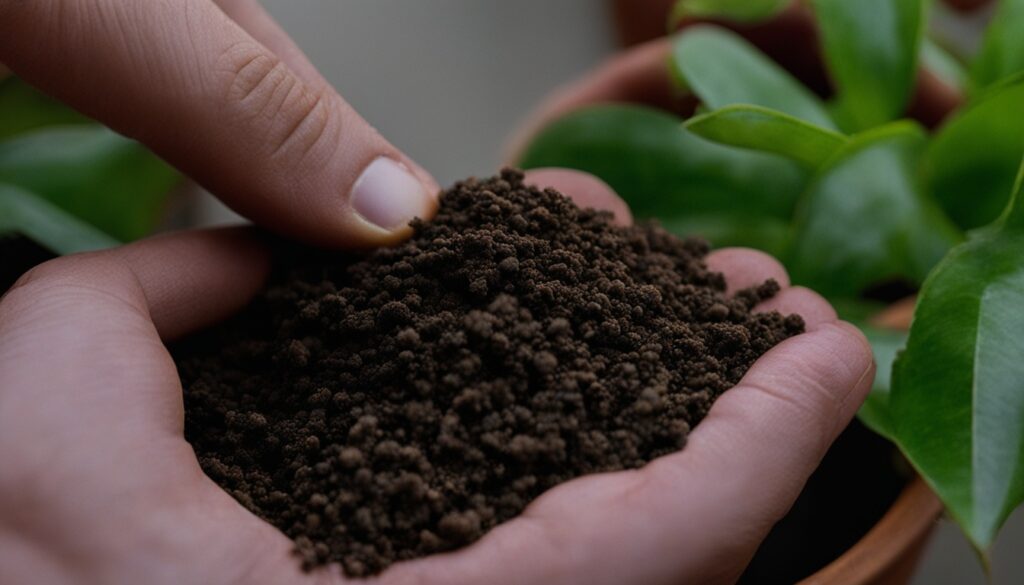
Ficus Neriifolia Maintenance
Keeping your Ficus Neriifolia healthy and thriving is key. This plant, also known as the willow-leaf fig or Benjamin fig, needs proper care. You must prune it often to control its size and shape. Watch out for pests and diseases too.
Pruning and Shaping
Pruning ficus neriifolia regularly is a must. This keeps your plant looking the way you want. Use sharp scissors to cut away any bad or too much growth. Pinch back new growth to make it look full and bushy. If you want it to look more like a tree, cut away the bottom branches.

Shaping your ficus neriifolia right is important. This is what gives you the look you’re going for, whether it’s a busy plant or a small indoor tree. Keep pruning it to make it grow healthy and well-shaped.
Pest and Disease Management
The Ficus Neriifolia is pretty tough, but it can still get pests. Spider mites, mealybugs, and scale insects are the usual suspects. Check your plant often. If you find pests, treat them with insecticidal soap or neem oil right away.
Some common problems are root rot and leaf spot. Root rot is from too much water. Leaf spot makes spots on the leaves. Fixing the watering and letting in more air can help. Find these problems early and treat them right to help your plant bounce back.
| Pest/Disease | Symptoms | Treatment |
|---|---|---|
| Spider mites | Yellowing leaves, webbing | Neem oil, horticultural oils |
| Mealybugs | White cottony masses | Insecticidal soap, alcohol wipes |
| Scale insects | Brown or white bumps on stems | Horticultural oils, manual removal |
| Root rot | Wilting, leaf drop, foul odor | Repot in fresh soil, adjust watering |
| Leaf spot | Brown or yellow spots on leaves | Improve air circulation, fungicide treatment |
Being watchful and dealing with problems quickly will keep your Ficus Neriifolia in top shape. This means it stays pest-free and disease-free. So, it looks good and grows well.
Fertilizing Your Ficus Neriifolia
Fertilizing your Ficus Neriifolia correctly is key. It helps keep the plant looking strong and green. Even though this plant doesn’t need a lot of care, the right nutrients can make a big difference.
Types of Fertilizers
Fertilizing your Ficus Neriifolia has many options. Use a balanced, water-soluble fertilizer for houseplants. It has all the nutrients your plant needs to grow well. If you prefer organic fertilizers, fish emulsion or compost tea are good choices. They feed your plant and keep the soil healthy.
Fertilizing Schedule
Know when to fertilize your Ficus Neriifolia based on its growth. In the active season, from spring to summer, do it every 4-6 weeks. This helps the plant grow more leaves and get denser.
In winter, when the plant is not growing much, its food needs drop. You can stop or lower the fertilizer then. This keeps the soil from getting too salty. Start feeding it again in spring, when it picks up new growth.
Always read the label on your fertilizer. Too much can harm your plant. It might burn the roots and leaves.
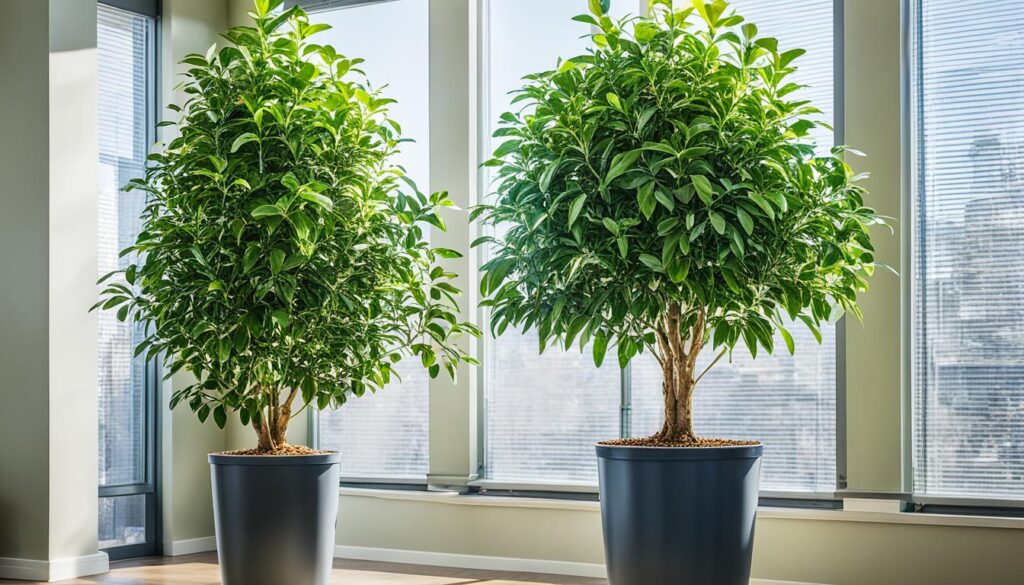
Choosing the right fertilizer and feeding your Ficus Neriifolia at the perfect time means a healthy, beautiful indoor plant.
Common Problems and Troubleshooting
The Ficus Neriifolia, or the willow-leaf fig, is easy to care for. Yet, it might face some common issues. Knowing how to spot and fix these problems is key to a healthy plant.
Leaf Drop and Discoloration
Leaf drop and discoloration are common in the Ficus plant. Many things can cause this – wrong watering, low humidity, big temperature changes, and not enough light. If leaves turn yellow or brown, or fall off, find the cause fast.
If the issue lingers, look for bugs or diseases. Then, take the right steps to fix them.
Root Rot and Other Diseases
Too much water can cause root rot. Signs include wilting, leaf loss, and a bad smell from the soil. Acting fast against root rot is crucial to your plant’s survival.
Early on, change the plant into fresh, well-draining soil. Also, water it better. Diseases like leaf spot and powdery mildew can be beaten by more air around the plant. Using the right fungicides can help, too.
| Issue | Cause | Solution |
|---|---|---|
| Leaf drop | Improper watering, low humidity, temperature fluctuations, insufficient light | Adjust watering schedule, increase humidity, maintain consistent temperature, provide adequate light |
| Yellow leaves | Overwatering, nutrient deficiencies | Reduce watering, fertilize with balanced fertilizer |
| Root rot | Overwatering, poorly draining soil | Repot in well-draining soil, adjust watering practices |
| Leaf spot, powdery mildew | Poor air circulation, high humidity | Improve air flow, treat with fungicides if necessary |
Watching your Ficus Neriifolia well can keep it healthy and beautiful. Troubleshoot problems fast to enjoy your plant for years.
Tips for Propagating Ficus Neriifolia
The Ficus neriifolia is easy to grow from cuttings. This lets you make new plants from one you already have. In fact, it’s a cheap way to get more plants that look just like the original.
Start by snipping 4-6 inch pieces from the top of healthy, no-flower branches. Take off the bottom leaves and leave a few at the top. Then, dip the ends into a rooting hormone to help them grow roots faster.
Now, put the cuttings into soil that drains well. Mix peat moss, perlite, and soil for the best root spot. Keep the soil damp, not soaked, and put the cuttings where they’ll get plenty of light.
After a few weeks, you’ll begin to see roots. When they’re long enough, move each cutting into its own pot. This is also a good time to try other ways to make more plants, like air layering.
Handle your cuttings gently and give them what they need to grow. With a little time and care, you’ll have your own little forest of Ficus neriifolia. This will fill your home with beautiful greenery.
| Root-bound Issues | Overwatering Symptoms | Pot Materials |
|---|---|---|
| Roots circling the pot’s base or protruding through drainage holes, signaling a need for repotting. | Yellowing leaves, indicating a need for improved drainage. | Terracotta, plastic, and ceramic pots, each with pros and cons for maintaining the plant. |
- Importance of drainage for Ficus neriifolia: It’s key to avoid waterlogged roots. Use pots that allow water to escape.
- Suggested potting mix composition: Mix general soil with perlite or pumice for better breathing room.
- Size recommendation for new pots: Make them 2 inches bigger, with holes at the bottom for drainage.
- Guidelines for watering post-repotting: Water carefully after transplanting to help the roots recover. Do not overwater.
- Post-repotting plant care: Watch how your plant reacts, don’t feed it right away, and be mindful of how much water it needs.
Conclusion
Caring for a ficus neriifolia indoors needs specific steps. Homeowners must give it the right environment and follow key instructions to see it grow well. This way, your home can have the joy of this unique tree for many years.
When it comes to caring for a ficus neriifolia indoors, it is crucial to understand its needs. This plant can keep water in its structure like a succulent. This helps it survive through tough times without much care.
The ficus neriifolia can bounce back even after losing many leaves or being cut back hard. It grows new leaves quickly and can be shaped into a bonsai. This is because it tolerates strong pruning of its roots and branches well.
Here are some tips to help your ficus neriifolia grow strong:
- Use a shallow pot and well-draining soil for the tree.
- Let the soil dry somewhat between waterings. This simulates how the plant finds water naturally.
- Every few years, give it a new pot and trim any roots that have started to wrap around the bottom.
With the right care, your ficus neriifolia will show its strength and beauty in your home. Stay dedicated to these instructions, and your tree will thank you by flourishing.
Tips for Successful Ficus Neriifolia Growth
To make your ficus neriifolia grow well, you need to give it the right environment. This tropical plant likes a warm, moderately humid place. Room temperature, between 65°F and 85°F (18°C to 29°C), is good for it. It prefers higher humidity than what’s usually found in homes.
Ideal Environment for Growth
Don’t place your ficus neriifolia where it can feel drafts or close to air vents. Sudden temperature changes can make its leaves fall off. It does best in a place that’s always warm and a bit humid.
To keep the air around it moist, use a pebble tray or a humidifier. You can also mist its leaves. But, watch out not to water it too much. Too much water can harm the roots.
Grooming and Maintenance Routine
It’s key to keep up with grooming and maintenance for your ficus neriifolia. Dust the leaves regularly, cut off any unhealthy leaves, and look for bugs or diseases. This will help it stay healthy and look good.
Turn your plant every now and then to keep it growing evenly. This also stops it from leaning too much towards the light. Regular care will keep your plant in a good shape and thriving.
| Task | Frequency |
|---|---|
| Wipe down leaves | Monthly |
| Remove dead/damaged foliage | As needed |
| Inspect for pests/diseases | Weekly |
| Rotate plant | Every 2-3 weeks |
By sticking to a regular care routine and giving it a good home, your ficus neriifolia will be a joy for many years.
Showcasing Your Ficus Neriifolia in Home Decor
The Ficus Neriifolia adds something special to any room with its willow-like leaves. It fits well with the right planters or containers. This tropical plant can transform your space when displayed well.
Decorative Containers and Planters
Your Ficus Neriifolia will look great in a suitable pot, like ceramic or terra cotta. These pots come in many colors and designs to blend in with your home. Make sure the pot has holes for water to drain and a saucer to catch it. A braided basket or a woven planter adds a cozy, natural touch to your space.
Incorporating Ficus Neriifolia into Interior Design
The Ficus Neriifolia is great for many home styles. It brings a lush, tropical look to your living areas. You can also train it to grow like a tree for a stunning look in your main areas. Place it where there’s natural light or use it to soften corners. Mix it with other plants for a rich, green effect. The Ficus Neriifolia is really versatile and can fit any home decor style.


